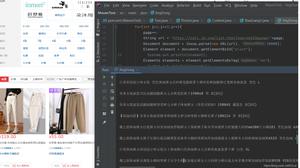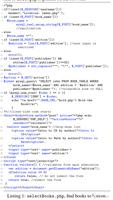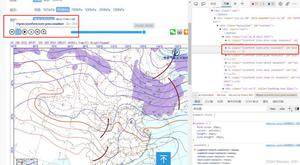Python3爬虫入门:Scrapy的基本使用

Scrapy 入门
接下来介绍一个简单的项目,完成一遍 Scrapy 抓取流程。通过这个过程,我们可以对 Scrapy 的基本用法和原理有大体了解。
1. 本节目标
本节要完成的任务如下。
创建一个 Scrapy 项目。
创建一个 Spider 来抓取站点和处理数据。
通过命令行将抓取的内容导出。
将抓取的内容保存到 MongoDB 数据库。
2. 准备工作
我们需要安装好 Scrapy 框架、MongoDB 和 PyMongo 库。如果尚未安装,请参照上一节的安装说明。
3. 创建项目
创建一个 Scrapy 项目,项目文件可以直接用 scrapy 命令生成,命令如下所示:
scrapy startproject tutorial
这个命令可以在任意文件夹运行。如果提示权限问题,可以加 sudo 运行该命令。这个命令将会创建一个名为 tutorial 的文件夹,文件夹结构如下所示:
scrapy.cfg # Scrapy 部署时的配置文件tutorial # 项目的模块,引入的时候需要从这里引入
__init__.py
items.py # Items 的定义,定义爬取的数据结构
middlewares.py # Middlewares 的定义,定义爬取时的中间件
pipelines.py # Pipelines 的定义,定义数据管道
settings.py # 配置文件
spiders # 放置 Spiders 的文件夹
__init__.py
4. 创建 Spider
Spider 是自己定义的类,Scrapy 用它来从网页里抓取内容,并解析抓取的结果。不过这个类必须继承 Scrapy 提供的 Spider 类 scrapy.Spider,还要定义 Spider 的名称和起始请求,以及怎样处理爬取后的结果的方法。
也可以使用命令行创建一个 Spider。比如要生成 Quotes 这个 Spider,可以执行如下命令:
cd tutorialscrapy genspider quotes
进入刚才创建的 tutorial 文件夹,然后执行 genspider 命令。第一个参数是 Spider 的名称,第二个参数是网站域名。执行完毕之后,spiders 文件夹中多了一个 quotes.py,它就是刚刚创建的 Spider,内容如下所示:
import scrapyclass QuotesSpider(scrapy.Spider):
name = "quotes"
allowed_domains = ["quotes.toscrape.com"]
start_urls = ['http://quotes.toscrape.com/']
def parse(self, response):
pass
这里有三个属性 ——name、allowed_domains 和 start_urls,还有一个方法 parse。
name,它是每个项目唯一的名字,用来区分不同的 Spider。
allowed_domains,它是允许爬取的域名,如果初始或后续的请求链接不是这个域名下的,则请求链接会被过滤掉。
start_urls,它包含了 Spider 在启动时爬取的 url 列表,初始请求是由它来定义的。
parse,它是 Spider 的一个方法。默认情况下,被调用时 start_urls 里面的链接构成的请求完成下载执行后,返回的响应就会作为唯一的参数传递给这个函数。该方法负责解析返回的响应、提取数据或者进一步生成要处理的请求。
5. 创建 Item
Item 是保存爬取数据的容器,它的使用方法和字典类似。不过,相比字典,Item 多了额外的保护机制,可以避免拼写错误或者定义字段错误。
创建 Item 需要继承 scrapy.Item 类,并且定义类型为 scrapy.Field 的字段。观察目标网站,我们可以获取到的内容有 text、author、tags。
定义 Item,此时将 items.py 修改如下:
import scrapyclass QuoteItem(scrapy.Item):
text = scrapy.Field()
author = scrapy.Field()
tags = scrapy.Field()
这里定义了三个字段,将类的名称修改为 QuoteItem,接下来爬取时我们会使用到这个 Item。
6. 解析 Response
前面我们看到,parse() 方法的参数 response 是 start_urls 里面的链接爬取后的结果。所以在 parse() 方法中,我们可以直接对 response 变量包含的内容进行解析,比如浏览请求结果的网页源代码,或者进一步分析源代码内容,或者找出结果中的链接而得到下一个请求。
我们可以看到网页中既有我们想要的结果,又有下一页的链接,这两部分内容我们都要进行处理。
首先看看网页结构,如图 13-2 所示。每一页都有多个 class 为 quote 的区块,每个区块内都包含 text、author、tags。那么我们先找出所有的 quote,然后提取每一个 quote 中的内容。
图 13-2 页面结构
提取的方式可以是 CSS 选择器或 XPath 选择器。在这里我们使用 CSS 选择器进行选择,parse() 方法的改写如下所示:
def parse(self, response):quotes = response.css('.quote')
for quote in quotes:
text = quote.css('.text::text').extract_first()
author = quote.css('.author::text').extract_first()
tags = quote.css('.tags .tag::text').extract()
这里首先利用选择器选取所有的 quote,并将其赋值为 quotes 变量,然后利用 for 循环对每个 quote 遍历,解析每个 quote 的内容。
对 text 来说,观察到它的 class 为 text,所以可以用.text 选择器来选取,这个结果实际上是整个带有标签的节点,要获取它的正文内容,可以加::text 来获取。这时的结果是长度为 1 的列表,所以还需要用 extract_first() 方法来获取第一个元素。而对于 tags 来说,由于我们要获取所有的标签,所以用 extract() 方法获取整个列表即可。
以第一个 quote 的结果为例,各个选择方法及结果的说明如下内容。
源码如下:
<div class="quote" itemscope=""itemtype="http://schema.org/CreativeWork"><span class="text" itemprop="text">“The world as we have created it is a process of our thinking.
It cannot be changed without changing our thinking.”</span>
<span>by <small class="author" itemprop="author">Albert Einstein</small>
<a href="/author/Albert-Einstein">(about)</a>
</span>
<div class="tags">
Tags:
<meta class="keywords" itemprop="keywords" content="change,deep-thoughts,thinking,world">
<a class="tag" href="/tag/change/page/1/">change</a>
<a class="tag" href="/tag/deep-thoughts/page/1/">deep-thoughts</a>
<a class="tag" href="/tag/thinking/page/1/">thinking</a>
<a class="tag" href="/tag/world/page/1/">world</a>
</div>
</div>
不同选择器的返回结果如下。
quote.css(‘.text’)
[<Selector xpath="descendant-or-self::*[@class and contains(concat(' ', normalize-space(@class), ' '), ' text ')]"data='<span class="text"itemprop="text">“The '>]
quote.css(‘.text::text’)
[<Selector xpath="descendant-or-self::*[@class and contains(concat(' ', normalize-space(@class), ' '), ' text ')]/text()"data='“The world as we have created it is a pr'>]
quote.css(‘.text’).extract()
['<span class="text"itemprop="text">“The world as we have created it is a process of our thinking. It cannot bechanged without changing our thinking.”</span>']
quote.css(‘.text::text’).extract()
['“The world as we have created it is a process of our thinking. It cannot be changed without changing ourthinking.”']
quote.css(‘.text::text’).extract_first()
“The world as we have created it is a process of our thinking. It cannot be changed without changing our thinking.”
所以,对于 text,获取结果的第一个元素即可,所以使用 extract_first() 方法,对于 tags,要获取所有结果组成的列表,所以使用 extract() 方法。
7. 使用 Item
上文定义了 Item,接下来就要使用它了。Item 可以理解为一个字典,不过在声明的时候需要实例化。然后依次用刚才解析的结果赋值 Item 的每一个字段,最后将 Item 返回即可。
QuotesSpider 的改写如下所示:
import scrapyfrom tutorial.items import QuoteItem
class QuotesSpider(scrapy.Spider):
name = "quotes"
allowed_domains = ["quotes.toscrape.com"]
start_urls = ['http://quotes.toscrape.com/']
def parse(self, response):
quotes = response.css('.quote')
for quote in quotes:
item = QuoteItem()
item['text'] = quote.css('.text::text').extract_first()
item['author'] = quote.css('.author::text').extract_first()
item['tags'] = quote.css('.tags .tag::text').extract()
yield item
如此一来,首页的所有内容被解析出来,并被赋值成了一个个 QuoteItem。
8. 后续 Request
上面的操作实现了从初始页面抓取内容。那么,下一页的内容该如何抓取?这就需要我们从当前页面中找到信息来生成下一个请求,然后在下一个请求的页面里找到信息再构造再下一个请求。这样循环往复迭代,从而实现整站的爬取。
将刚才的页面拉到最底部,如图 13-3 所示。
图 13-3 页面底部
有一个 Next 按钮,查看一下源代码,可以发现它的链接是 /page/2/,实际上全链接就是:http://quotes.toscrape.com/page/2,通过这个链接我们就可以构造下一个请求。
构造请求时需要用到 scrapy.Request。这里我们传递两个参数 ——url 和 callback,这两个参数的说明如下。
url:它是请求链接。
callback:它是回调函数。当指定了该回调函数的请求完成之后,获取到响应,引擎会将该响应作为参数传递给这个回调函数。回调函数进行解析或生成下一个请求,回调函数如上文的 parse() 所示。
由于 parse() 就是解析 text、author、tags 的方法,而下一页的结构和刚才已经解析的页面结构是一样的,所以我们可以再次使用 parse() 方法来做页面解析。
接下来我们要做的就是利用选择器得到下一页链接并生成请求,在 parse() 方法后追加如下的代码:
next = response.css('.pager .next a::attr(href)').extract_first()url = response.urljoin(next)
yield scrapy.Request(url=url, callback=self.parse)
第一句代码首先通过 CSS 选择器获取下一个页面的链接,即要获取 a 超链接中的 href 属性。这里用到了::attr(href) 操作。然后再调用 extract_first() 方法获取内容。
第二句代码调用了 urljoin() 方法,urljoin() 方法可以将相对 URL 构造成一个绝对的 URL。例如,获取到的下一页地址是 /page/2,urljoin() 方法处理后得到的结果就是:http://quotes.toscrape.com/page/2/。
第三句代码通过 url 和 callback 变量构造了一个新的请求,回调函数 callback 依然使用 parse() 方法。这个请求完成后,响应会重新经过 parse 方法处理,得到第二页的解析结果,然后生成第二页的下一页,也就是第三页的请求。这样爬虫就进入了一个循环,直到最后一页。
通过几行代码,我们就轻松实现了一个抓取循环,将每个页面的结果抓取下来了。
现在,改写之后的整个 Spider 类如下所示:
import scrapyfrom tutorial.items import QuoteItem
class QuotesSpider(scrapy.Spider):
name = "quotes"
allowed_domains = ["quotes.toscrape.com"]
start_urls = ['http://quotes.toscrape.com/']
def parse(self, response):
quotes = response.css('.quote')
for quote in quotes:
item = QuoteItem()
item['text'] = quote.css('.text::text').extract_first()
item['author'] = quote.css('.author::text').extract_first()
item['tags'] = quote.css('.tags .tag::text').extract()
yield item
next = response.css('.pager .next a::attr("href")').extract_first()
url = response.urljoin(next)
yield scrapy.Request(url=url, callback=self.parse)
9. 运行
接下来,进入目录,运行如下命令:
scrapy crawl quotes
就可以看到 Scrapy 的运行结果了。
2017-02-19 13:37:20 [scrapy.utils.log] INFO: Scrapy 1.3.0 started (bot: tutorial)2017-02-19 13:37:20 [scrapy.utils.log] INFO: Overridden settings: {'NEWSPIDER_MODULE': 'tutorial.spiders',
'SPIDER_MODULES': ['tutorial.spiders'], 'ROBOTSTXT_OBEY': True, 'BOT_NAME': 'tutorial'}
2017-02-19 13:37:20 [scrapy.middleware] INFO: Enabled extensions:
['scrapy.extensions.logstats.LogStats',
'scrapy.extensions.telnet.TelnetConsole',
'scrapy.extensions.corestats.CoreStats']
2017-02-19 13:37:20 [scrapy.middleware] INFO: Enabled downloader middlewares:
['scrapy.downloadermiddlewares.robotstxt.RobotsTxtMiddleware',
'scrapy.downloadermiddlewares.httpauth.HttpAuthMiddleware',
'scrapy.downloadermiddlewares.downloadtimeout.DownloadTimeoutMiddleware',
'scrapy.downloadermiddlewares.defaultheaders.DefaultHeadersMiddleware',
'scrapy.downloadermiddlewares.useragent.UserAgentMiddleware',
'scrapy.downloadermiddlewares.retry.RetryMiddleware',
'scrapy.downloadermiddlewares.redirect.MetaRefreshMiddleware',
'scrapy.downloadermiddlewares.httpcompression.HttpCompressionMiddleware',
'scrapy.downloadermiddlewares.redirect.RedirectMiddleware',
'scrapy.downloadermiddlewares.cookies.CookiesMiddleware',
'scrapy.downloadermiddlewares.stats.DownloaderStats']
2017-02-19 13:37:20 [scrapy.middleware] INFO: Enabled spider middlewares:
['scrapy.spidermiddlewares.httperror.HttpErrorMiddleware',
'scrapy.spidermiddlewares.offsite.OffsiteMiddleware',
'scrapy.spidermiddlewares.referer.RefererMiddleware',
'scrapy.spidermiddlewares.urllength.UrlLengthMiddleware',
'scrapy.spidermiddlewares.depth.DepthMiddleware']
2017-02-19 13:37:20 [scrapy.middleware] INFO: Enabled item pipelines:
[]
2017-02-19 13:37:20 [scrapy.core.engine] INFO: Spider opened
2017-02-19 13:37:20 [scrapy.extensions.logstats] INFO: Crawled 0 pages (at 0 pages/min), scraped 0 items
(at 0 items/min)
2017-02-19 13:37:20 [scrapy.extensions.telnet] DEBUG: Telnet console listening on 127.0.0.1:6023
2017-02-19 13:37:21 [scrapy.core.engine] DEBUG: Crawled (404) <GET http://quotes.toscrape.com/robots.txt>
(referer: None)
2017-02-19 13:37:21 [scrapy.core.engine] DEBUG: Crawled (200) <GET http://quotes.toscrape.com/> (referer: None)
2017-02-19 13:37:21 [scrapy.core.scraper] DEBUG: Scraped from <200 http://quotes.toscrape.com/>
{'author': u'Albert Einstein',
'tags': [u'change', u'deep-thoughts', u'thinking', u'world'],
'text': u'u201cThe world as we have created it is a process of our thinking. It cannot be changed without
changing our thinking.u201d'}
2017-02-19 13:37:21 [scrapy.core.scraper] DEBUG: Scraped from <200 http://quotes.toscrape.com/>
{'author': u'J.K. Rowling',
'tags': [u'abilities', u'choices'],
'text': u'u201cIt is our choices, Harry, that show what we truly are, far more than our abilities.u201d'}
...
2017-02-19 13:37:27 [scrapy.core.engine] INFO: Closing spider (finished)
2017-02-19 13:37:27 [scrapy.statscollectors] INFO: Dumping Scrapy stats:
{'downloader/request_bytes': 2859,
'downloader/request_count': 11,
'downloader/request_method_count/GET': 11,
'downloader/response_bytes': 24871,
'downloader/response_count': 11,
'downloader/response_status_count/200': 10,
'downloader/response_status_count/404': 1,
'dupefilter/filtered': 1,
'finish_reason': 'finished',
'finish_time': datetime.datetime(2017, 2, 19, 5, 37, 27, 227438),
'item_scraped_count': 100,
'log_count/DEBUG': 113,
'log_count/INFO': 7,
'request_depth_max': 10,
'response_received_count': 11,
'scheduler/dequeued': 10,
'scheduler/dequeued/memory': 10,
'scheduler/enqueued': 10,
'scheduler/enqueued/memory': 10,
'start_time': datetime.datetime(2017, 2, 19, 5, 37, 20, 321557)}
2017-02-19 13:37:27 [scrapy.core.engine] INFO: Spider closed (finished)
这里只是部分运行结果,中间一些抓取结果已省略。
首先,Scrapy 输出了当前的版本号以及正在启动的项目名称。接着输出了当前 settings.py 中一些重写后的配置。然后输出了当前所应用的 Middlewares 和 Pipelines。Middlewares 默认是启用的,可以在 settings.py 中修改。Pipelines 默认是空,同样也可以在 settings.py 中配置。后面会对它们进行讲解。
接下来就是输出各个页面的抓取结果了,可以看到爬虫一边解析,一边翻页,直至将所有内容抓取完毕,然后终止。
最后,Scrapy 输出了整个抓取过程的统计信息,如请求的字节数、请求次数、响应次数、完成原因等。
整个 Scrapy 程序成功运行。我们通过非常简单的代码就完成了一个网站内容的爬取,这样相比之前一点点写程序简洁很多。
10. 保存到文件
运行完 Scrapy 后,我们只在控制台看到了输出结果。如果想保存结果该怎么办呢?
要完成这个任务其实不需要任何额外的代码,Scrapy 提供的 Feed Exports 可以轻松将抓取结果输出。例如,我们想将上面的结果保存成 JSON 文件,可以执行如下命令:
scrapy crawl quotes -o quotes.json
命令运行后,项目内多了一个 quotes.json 文件,文件包含了刚才抓取的所有内容,内容是 JSON 格式。
另外我们还可以每一个 Item 输出一行 JSON,输出后缀为 jl,为 jsonline 的缩写,命令如下所示:
scrapy crawl quotes -o quotes.jl
或
scrapy crawl quotes -o quotes.jsonlines
输出格式还支持很多种,例如 csv、xml、pickle、marshal 等,还支持 ftp、s3 等远程输出,另外还可以通过自定义 ItemExporter 来实现其他的输出。
例如,下面命令对应的输出分别为 csv、xml、pickle、marshal 格式以及 ftp 远程输出:
scrapy crawl quotes -o quotes.csvscrapy crawl quotes -o quotes.xml
scrapy crawl quotes -o quotes.pickle
scrapy crawl quotes -o quotes.marshal
scrapy crawl quotes -o ftp://user:pass@ftp.example.com/path/to/quotes.csv
其中,ftp 输出需要正确配置用户名、密码、地址、输出路径,否则会报错。
通过 Scrapy 提供的 Feed Exports,我们可以轻松地输出抓取结果到文件。对于一些小型项目来说,这应该足够了。不过如果想要更复杂的输出,如输出到数据库等,我们可以使用 Item Pileline 来完成。
11. 使用 Item Pipeline
如果想进行更复杂的操作,如将结果保存到 MongoDB 数据库,或者筛选某些有用的 Item,则我们可以定义 Item Pipeline 来实现。
Item Pipeline 为项目管道。当 Item 生成后,它会自动被送到 Item Pipeline 进行处理,我们常用 Item Pipeline 来做如下操作。
清洗 HTML 数据
验证爬取数据,检查爬取字段
查重并丢弃重复内容
将爬取结果储存到数据库
要实现 Item Pipeline 很简单,只需要定义一个类并实现 process_item() 方法即可。启用 Item Pipeline 后,Item Pipeline 会自动调用这个方法。process_item() 方法必须返回包含数据的字典或 Item 对象,或者抛出 DropItem 异常。
process_item() 方法有两个参数。一个参数是 item,每次 Spider 生成的 Item 都会作为参数传递过来。另一个参数是 spider,就是 Spider 的实例。
接下来,我们实现一个 Item Pipeline,筛掉 text 长度大于 50 的 Item,并将结果保存到 MongoDB。
修改项目里的 pipelines.py 文件,之前用命令行自动生成的文件内容可以删掉,增加一个 TextPipeline 类,内容如下所示:
from scrapy.exceptions import DropItemclass TextPipeline(object):
def __init__(self):
self.limit = 50
def process_item(self, item, spider):
if item['text']:
if len(item['text']) > self.limit:
item['text'] = item['text'][0:self.limit].rstrip() + '...'
return item
else:
return DropItem('Missing Text')
这段代码在构造方法里定义了限制长度为 50,实现了 process_item() 方法,其参数是 item 和 spider。首先该方法判断 item 的 text 属性是否存在,如果不存在,则抛出 DropItem 异常;如果存在,再判断长度是否大于 50,如果大于,那就截断然后拼接省略号,再将 item 返回即可。
接下来,我们将处理后的 item 存入 MongoDB,定义另外一个 Pipeline。同样在 pipelines.py 中,我们实现另一个类 MongoPipeline,内容如下所示:
import pymongoclass MongoPipeline(object):
def __init__(self, mongo_uri, mongo_db):
self.mongo_uri = mongo_uri
self.mongo_db = mongo_db
@classmethod
def from_crawler(cls, crawler):
return cls(mongo_uri=crawler.settings.get('MONGO_URI'),
mongo_db=crawler.settings.get('MONGO_DB')
)
def open_spider(self, spider):
self.client = pymongo.MongoClient(self.mongo_uri)
self.db = self.client[self.mongo_db]
def process_item(self, item, spider):
name = item.__class__.__name__
self.db[name].insert(dict(item))
return item
def close_spider(self, spider):
self.client.close()
MongoPipeline 类实现了 API 定义的另外几个方法。
from_crawler,这是一个类方法,用 @classmethod 标识,是一种依赖注入的方式,方法的参数就是 crawler,通过 crawler 这个我们可以拿到全局配置的每个配置信息,在全局配置 settings.py 中我们可以定义 MONGO_URI 和 MONGO_DB 来指定 MongoDB 连接需要的地址和数据库名称,拿到配置信息之后返回类对象即可。所以这个方法的定义主要是用来获取 settings.py 中的配置的。
open_spider,当 Spider 被开启时,这个方法被调用。在这里主要进行了一些初始化操作。
close_spider,当 Spider 被关闭时,这个方法会调用,在这里将数据库连接关闭。
最主要的 process_item() 方法则执行了数据插入操作。
定义好 TextPipeline 和 MongoPipeline 这两个类后,我们需要在 settings.py 中使用它们。MongoDB 的连接信息还需要定义。
我们在 settings.py 中加入如下内容:
ITEM_PIPELINES = { 'tutorial.pipelines.TextPipeline': 300,
'tutorial.pipelines.MongoPipeline': 400,
}
MONGO_URI='localhost'
MONGO_DB='tutorial'
赋值 ITEM_PIPELINES 字典,键名是 Pipeline 的类名称,键值是调用优先级,是一个数字,数字越小则对应的 Pipeline 越先被调用。
再重新执行爬取,命令如下所示:
scrapy crawl quotes
爬取结束后,MongoDB 中创建了一个 tutorial 的数据库、QuoteItem 的表,如图 13-4 所示。
图 13-4 爬取结果
长的 text 已经被处理并追加了省略号,短的 text 保持不变,author 和 tags 也都相应保存。
12. 源代码
本节代码地址:https://github.com/Python3WebSpider/ScrapyTutorial。
13. 结语
我们通过抓取 Quotes 网站完成了整个 Scrapy 的简单入门。但这只是冰山一角,还有很多内容等待我们去探索。
众多python教程,尽在网,欢迎在线学习!
本文转自:https://cuiqingcai.com/8337.html
以上是 Python3爬虫入门:Scrapy的基本使用 的全部内容, 来源链接: utcz.com/z/521764.html







